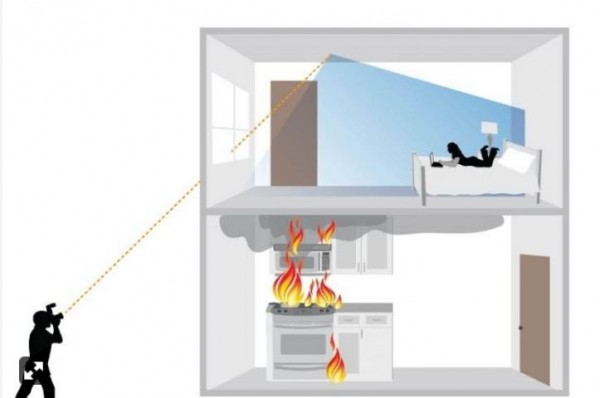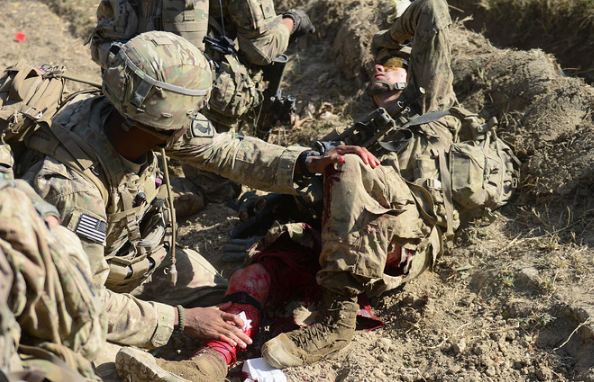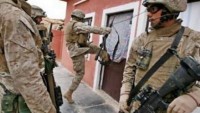DARPA-funded Camera can see Around and Behind Walls
| Arthur Dominic Villasanta | | Aug 03, 2016 06:28 AM EDT |
(Photo : Morgridge Institute for Research) Seeing around corners technology could help emergency personnel identify people in danger during fires or natural disasters
The U.S. Defense Advanced Research Projects Agency (DARPA) is fast tracking a novel technology to develop a special "camera" that can see around corners and behind walls. The technology, however, can't be used for ordinary cameras such as those on mobile phones.
DARPA is providing the $4.4 million grant to the Morgridge Institute for Research, a private, nonprofit biomedical research institute in Madison, Wisconsin affiliated with the University of Wisconsin-Madison (UW-Madison).
Like Us on Facebook
The DARPA grant will allow the Morgridge research team to explore the limitations of the technology and develop fully-functional hardware that can be used by U.S. soldiers, civilians, firemen and policemen.
It will fund four years of research. The first two years will be dedicated to investigating the full potential of the technology. The second two years will be spent developing the hardware, making it viable for production and implementation.
UW-Madison is one of eight universities to receive DAPRA grants this year to investigate different forms and applications of non-line-of-sight imaging.
The see around the corner technology was first developed by Massachusetts Institute of Technology scientist Andreas Velten and demonstrated for the first time in 2012.
Velten's technology relies on the camera firing a rapid pulse of laser light into a room. The laser light scatters when it hits a wall, ceiling, a person and other objects in a room. Many photons are eventually reflected back to an extremely sensitive sensor in camera. The sensor uses that information to digitally reconstruct an image of the room, including any people inside of it.
Recording the photons that reflected back to the camera requires highly specialized equipment. The very sensitive sensor is also able to see around multiple walls, a goal the team is currently working toward.
"The more times you can bounce this light within a scene, the more possible data you can collect," said Velten. "Since the first light is the strongest, and each proceeding bounce gets weaker and weaker, the sensor has to be sensitive enough to capture even a few photons of light."
Velten is collaborating with Mohit Gupta, assistant professor of computer sciences at UW-Madison, to develop the technology further. They are creating new versions of the camera where laser light bounces six or more times to uncover objects or persons outside the field of view, an advantage especially useful for soldiers.
TagsDefense Advanced Research Projects Agenc, DARPA, Morgridge Institute for Research, Andreas Velten, Mohit Gupta
©2015 Chinatopix All rights reserved. Do not reproduce without permission
EDITOR'S PICKS
-

Did the Trump administration just announce plans for a trade war with ‘hostile’ China and Russia?
-

US Senate passes Taiwan travel bill slammed by China
-

As Yan Sihong’s family grieves, here are other Chinese students who went missing abroad. Some have never been found
-

Beijing blasts Western critics who ‘smear China’ with the term sharp power
-

China Envoy Seeks to Defuse Tensions With U.S. as a Trade War Brews
-

Singapore's Deputy PM Provides Bitcoin Vote of Confidence Amid China's Blanket Bans
-

China warns investors over risks in overseas virtual currency trading
-

Chinese government most trustworthy: survey
-

Kashima Antlers On Course For Back-To-Back Titles
MOST POPULAR
LATEST NEWS
Zhou Yongkang: China's Former Security Chief Sentenced to Life in Prison

China's former Chief of the Ministry of Public Security, Zhou Yongkang, has been given a life sentence after he was found guilty of abusing his office, bribery and deliberately ... Full Article
TRENDING STORY

China Pork Prices Expected to Stabilize As The Supplies Recover

Elephone P9000 Smartphone is now on Sale on Amazon India

There's a Big Chance Cliffhangers Won't Still Be Resolved When Grey's Anatomy Season 13 Returns

Supreme Court Ruled on Samsung vs Apple Dispute for Patent Infringement

Microsoft Surface Pro 5 Rumors and Release Date: What is the Latest?














